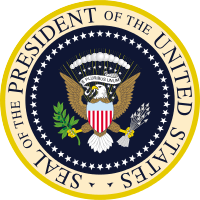Presidency of William McKinley
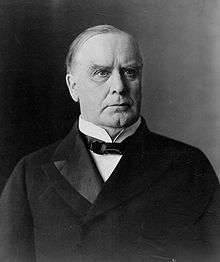
The presidency of William McKinley lasted from McKinley's election in ovember 1896 to his inauguration on March 20, 1897 to his death on September 14, 1901. McKinley led the nation to victory in the Spanish–American War, took ownership of Hawaii, the Philippines and Puerto Rico, restored prosperity, promoted pluralism among all groups, raised protective tariffs to promote American industry, and maintained the nation on the gold standard in a rejection of inflationary proposals. McKinley, the 25th President of the United States, won two presidential terms but was assassinated six months into his second term. He was succeeded by Vice President Theodore Roosevelt.
A former governor of Ohio, McKinley took office amid a deep economic depression. He had defeated his 1896 Democratic rival, William Jennings Bryan, after a front-porch campaign in which he advocated "sound money" (the gold standard unless altered by international agreement) and promised that high tariffs would restore prosperity. Rapid economic growth marked McKinley's presidency. He promoted the 1897 Dingley Tariff to protect manufacturers and factory workers from foreign competition, and in 1900, he secured the passage of the Gold Standard Act. McKinley hoped to persuade Spain to grant independence to rebellious Cuba without conflict, but when negotiation failed, he led the nation in the Spanish–American War of 1898; the U.S. victory was quick and decisive. As part of the peace settlement, Spain turned over to the United States its main overseas colonies of Puerto Rico, Guam, and the Philippines; Cuba was promised independence, but at that time remained under the control of the U.S. Army. The United States annexed the independent Republic of Hawaii in 1898 and it became a U.S. territory. McKinley defeated Bryan again in the 1900 presidential election, in a campaign focused on imperialism, protectionism, and free silver. As an innovator of American interventionism and pro-business sentiment, McKinley's presidency is generally considered above average, though his universally positive public perception was soon overshadowed by Roosevelt.
Inauguration

McKinley was sworn in as president on March 4, 1897, as his wife and mother looked on. The new President gave a lengthy inaugural address; he urged tariff reform, and stated that the currency issue would have to await tariff legislation. He warned against foreign interventions, "We want no wars of conquest. We must avoid the temptation of territorial aggression."[1]
Personnel and appointments
Cabinet
| The McKinley Cabinet | ||
|---|---|---|
| Office | Name | Term |
| President | William McKinley | 1897–1901 |
| Vice President | Garret A. Hobart | 1897–1899 |
| none | 1899–1901 | |
| Theodore Roosevelt | 1901 | |
| Secretary of State | John Sherman | 1897–1898 |
| William R. Day | 1898 | |
| John M. Hay | 1898–1901 | |
| Secretary of Treasury | Lyman J. Gage | 1897–1901 |
| Secretary of War | Russell A. Alger | 1897–1899 |
| Elihu Root | 1899–1901 | |
| Attorney General | Joseph McKenna | 1897–1898 |
| John W. Griggs | 1898–1901 | |
| Philander C. Knox | 1901 | |
| Postmaster General | James A. Gary | 1897–1898 |
| Charles Emory Smith | 1898–1901 | |
| Secretary of the Navy | John D. Long | 1897–1901 |
| Secretary of the Interior | Cornelius N. Bliss | 1897–1899 |
| Ethan A. Hitchcock | 1899–1901 | |
| Secretary of Agriculture | James Wilson | 1897–1901 |
McKinley's most controversial Cabinet appointment was that of John Sherman as Secretary of State.[2] Sherman was not McKinley's first choice for the position; he initially offered it to Senator William B. Allison. One consideration in Senator Sherman's appointment was to provide a place in the Senate for Mark Hanna, McKinley's close ally who had turned down a Cabinet position as Postmaster General. As Sherman had served as Secretary of the Treasury under Hayes, only the State position, the leading Cabinet post, was likely to entice him from the Senate. Sherman's mental faculties were decaying even in 1896; this was widely spoken of in political circles, but McKinley did not believe the rumors. Nevertheless, McKinley sent his cousin, William McKinley Osborne, to have dinner with the 73-year-old senator; he reported back that Sherman seemed as lucid as ever. McKinley wrote once the appointment was announced, "the stories regarding Senator Sherman's 'mental decay' are without foundation ... When I saw him last I was convinced both of his perfect health, physically and mentally, and that the prospects of life were remarkably good."[3][4]
Ohio Governor Bushnell appointed Hanna to the Senate. Once in Cabinet office, Sherman's mental incapacity became increasingly apparent. He was often bypassed by his first assistant, McKinley's Canton crony Judge William Day, and by the second secretary, Alvey A. Adee. Day, an Ohio lawyer unfamiliar with diplomacy, was often reticent in meetings; Adee was somewhat deaf. One diplomat characterized the arrangement, "the head of the department knew nothing, the first assistant said nothing, and the second assistant heard nothing".[5]
Maine Congressman Nelson Dingley Jr. was McKinley's choice for Secretary of the Treasury; he declined it, preferring to remain as chairman of the Ways and Means Committee in charge of writing tax and tariff laws. Charles Dawes, who had been Hanna's lieutenant in Chicago during the campaign, was considered for the Treasury post but by some accounts Dawes considered himself too young. Dawes eventually became Comptroller of the Currency; he recorded in his published diary that he had strongly urged McKinley to appoint as secretary the successful candidate, Lyman J. Gage, president of the First National Bank of Chicago and a Gold Democrat.[6] The Navy Department was offered to former Massachusetts Congressman John Davis Long, an old friend from the House.[7] Although McKinley was initially inclined to allow Long to choose his own the Assistant Secretary of the Navy, there was considerable pressure on the President-elect to appoint Theodore Roosevelt, head of the New York City Police Commission and a former state assemblyman. McKinley was reluctant, stating to one Roosevelt booster, "I want peace and I am told that your friend Theodore is always getting into rows with everybody." Nevertheless, appointed Roosevelt.[8]
In addition to Sherman, McKinley made one other ill-advised Cabinet appointment,[9] that of Secretary of War, which fell to Russell A. Alger, former general and Michigan governor. Competent enough in peacetime, Alger proved inadequate once the conflict with Spain began. With the War Department plagued by scandal, Alger resigned at McKinley's request in mid-1899.[10] Vice President Hobart, as was customary at the time, was not invited to Cabinet meetings. However, he proved a valuable adviser both for McKinley and for his Cabinet members. The wealthy Vice President leased a residence close to the White House; the two families visited each other without formality, and the Vice President's wife, Jennie Tuttle Hobart, sometimes substituted as Executive Mansion hostess when Ida McKinley was unwell.[11] For most of McKinley's administration, George B. Cortelyou served as his personal secretary. Cortelyou, who served in three Cabinet positions under Theodore Roosevelt, became a combination press secretary and chief of staff to McKinley.[12]
Judicial appointments
After the retirement of Justice Stephen Johnson Field, McKinley appointed Attorney General Joseph McKenna to the Supreme Court of the United States in December 1897.[13] The appointment aroused some controversy as McKenna's critics in the Senate said he was too closely associated with railroad interests and lacked the qualifications of a Supreme Court justice.[14] Despite the objections, McKenna's nomination was approved unanimously.[15] McKenna responded to the criticism of his legal education by taking some courses at Columbia Law School for several months before taking his seat.[14] McKenna served on the court until 1925, often taking centrist positions between more conservative and more progressive judges.[16] Along with his Supreme Court appointment, McKinley appointed six judges to the United States Courts of Appeals, and 28 judges to the United States district courts.[17]
Domestic policy
Prosperity returns
The long, deep depression that followed the Panic of 1893 finally ended in late 1896, as all the economic indicators in 1897 turned positive. Business newspapers and magazines were filled with optimistic reports throughout 1897. The New York Commercial of 3 January, 1898, surveyed a wide variety of businesses and industries nationwide, and concluded. "After three years of waiting and of false starts, the groundswell of demand is at last begun to rise with the steadiness which leaves little doubt that an era of prosperity has appeared." It reported that January 1898 represents, "a supreme moment in the period of transition from depression to comparative prosperity."[18] Unemployment, however, was a lagging indicator, and did not fully recover for years. Although the flow of migration practically stopped during the worst years of the Depression, immigration resumed in 1897, and added to the number of job seekers.
Tariffs and gold

Two of the great issues of the day, tariff reform and free silver, became intertwined in 1897. Ways and Means chairman Dingley introduced a new tariff bill (later called the Dingley Act) to revise the Wilson–Gorman Tariff Act of 1894. McKinley supported the bill, which increased tariffs on wool,sugar, and luxury goods, but the proposed new rates alarmed the French, who exported many luxury items to the United States.[19] The Dingley Act passed the House easily, but was delayed in the Senate as they assessed the French objections.[20] French representatives offered to cooperate with the United States in developing an international agreement on bimetallism if the new tariff rates were reduced; this pleased silverite Republicans in the Senate, whose votes were necessary for passage.[21] The Senate amended the bill to allow limited reciprocity (giving France some possibility of relief), but did not reduce the rates on luxury goods. McKinley signed the bill into law and agreed to begin negotiations on an international bimetallism standard.[22] American negotiators soon concluded a reciprocity treaty with France
McKinley in 1896 had promised bimetallism, using both gold and silver as monetary standards.[23] The US and France approached Britain to gauge British enthusiasm for bimetallism. The Prime Minister, Lord Salisbury, and his government showed some interest in the idea and told the American envoy, Edward O. Wolcott, that he would be amenable to reopening the mints in India to silver coinage if the Viceroy's Executive Council there agreed. News of a possible departure from the gold standard stirred up immediate opposition from its partisans, and misgivings by the Indian administration led Britain to reject the proposal.[24]
With the international effort a failure, McKinley turned away from silver coinage and embraced the gold standard. Agitation for free silver eased as prosperity returned and gold from recent strikes in the Yukon and Australia increased the monetary supply even without silver coinage.[25] In the absence of international agreement, McKinley favored legislation to formally affirm the gold standard, but was initially deterred by the silver strength in the Senate.[26] By 1900, with another campaign ahead and good economic conditions, McKinley urged Congress to pass such a law, and was able to sign the Gold Standard Act on March 14, 1900, using a gold pen to do so.[27][28] Bryan try to make free silver a campaign issue in 1900, but it failed to attract much attention.[29]
Pluralism
A key element of McKinley's appeal in a 1896 election was the spirit of pluralism. No group that America was to be ostracized or banned. Everyone was welcome to enjoy the new prosperity.[30] McKinley had a very broad appeal in terms of race, ethnicity, region and class. Where William Jennings Bryan had ridiculed and announced bankers, and railroads, McKinley welcomed the business community. McKinley was famous as a a champion of high tariffs to protect the high wages of American factory workers. He appointed Irish Catholic labor leader Terence Vincent Powderly founder of the Knights of Labor organization, as Commissioner-General of Immigration.[31] Proposals for immigration restriction, and attacks on Jews and Eastern and Southern Europeans had no place in the McKinley administration. Immigration restrictions proposed by Republican Senator Henry Cabot Lodge of Massachusetts and his allies in the Immigration Restriction League (founded in 1994) were ignored. The anti-Catholicism that had started to appear in the 1890s faded away, as shown by the rapid decline of the American Protective Association.[32]
While Cleveland and the Democrats had rejected annexation of multicultural Hawaii partly on racial grounds,[33] McKinley fought for and achieved annexation in 1896 and gave full U.S. citizenship to all citizens of Hawaii.
Reconciliation with the White South
A high priority for McKinley's pluralism was full unification of the white South psychologically patriotically back into the United States. The problem is that it conflicted with the civil rights of blacks, which were being increasingly restricted in the South. While McKinley did not officially endorse the "Lost Cause of the Confederacy", He did reach out in terms of appointments and speeches and visits to the white South. Reconciliation was achieved during the Spanish-American war, as enlistment rates across the South were quite high. The swift stunning victory certainly helped the reconciliation process.[34] Historian David W. Blight argues:
The Lost Cause became an integral part of national reconciliation by dint of sheer sentimentalism, by political argument, and by recurrent celebrations and rituals. For most white Southerners, the Lost Cause evolved into a language of vindication and renewal, as well as an array of practices and public monuments through which they could solidify both their Southern pride and their Americanness. In the 1890s, Confederate memories no longer dwelled as much on mourning or explaining defeat; they offered a set of conservative traditions by which the entire country could gird itself against racial, political, and industrial disorder. And by the sheer virtue of losing heroically the Confederate soldier provided a model of masculine devotion and courage in an age of gender anxieties and ruthless material striving.[35]
Growing racial tensions
Black leader Booker T. Washington and enunciated the principles for calming racial tensions in his Atlanta Exposition Speech of 1895. in which Southern blacks would work meekly and submit to white political rule, while Southern whites guaranteed that blacks would receive basic education and due process of law. Washington became the powerful leader of the black community nationwide, Helped direct the flow of philanthropic money into seven black schools, and was quietly consulted by McKinley and successive Republican presidents regarding patronage appointments. However, at the same time, great majority of blacks in the South lost their vote. [36]
The black vote supported McKinley in 1896 and African Americans were hopeful of progress towards equality. McKinley had spoken out against lynching while governor, and most African Americans who could vote supported him in 1896. McKinley's priority, however, was in ending sectionalism, and they were disappointed by his policies and appointments. Although McKinley made some appointments of African Americans to low-level government posts, and received some praise for that, the appointments were less than they had received under previous Republican administrations. Blanche K. Bruce, an African American who during Reconstruction had served as senator from Mississippi, received the post of register at the Treasury Department; this post was traditionally given to an African American by Republican presidents. McKinley appointed several black postmasters; however, when whites protested the appointment of Justin W. Lyons as postmaster of Augusta, Georgia, McKinley asked Lyons to withdraw (he was subsequently given the post of Treasury register after Bruce's death in 1898).[37] The President did appoint George B. Jackson, a former slave, to the post of customs collector in Presidio, Texas. However, African Americans in northern states felt that their contributions to McKinley's victory were overlooked; few were appointed to office.[37]
The administration's response to racial violence was minimal, causing him to lose black support.[37] When black postmasters at Hogansville, Georgia in 1897, and at Lake City, South Carolina the following year, were assaulted, McKinley issued no statement of condemnation. Although black leaders criticized McKinley for inaction, supporters responded by saying there was little the president could do to intervene. Critics replied by saying that he could at least publicly condemn such events, as Harrison had done.[38]

According to historian Clarance A. Bacote, "Before the Spanish–American War, the Negroes, in spite of some mistakes, regarded McKinley as the best friend they ever had."[39] African Americans saw the onset of war in 1898 as an opportunity to display their patriotism; and black soldiers fought bravely at El Caney and San Juan Hill. African Americans in the peacetime Army had formed elite units; nevertheless they were harassed by whites as they traveled from the West to Tampa for embarkation to the war. Under pressure from black leaders, McKinley required the War Department to commission black officers above the rank of lieutenant. The heroism of the black troops did not still racial tensions in the South, as the second half of 1898 saw several outbreaks of racial violence; 11 African Americans were killed in riots in Wilmington, North Carolina.[40] McKinley toured the South in late 1898, hoping for sectional reconciliation. In addition to visiting Tuskegee Institute and black educator Booker T. Washington, he addressed the Georgia legislature, wearing a badge of gray, and visited Confederate memorials. In his tour of the South, McKinley did not mention the racial tensions or violence. Although the President received a rapturous reception from Southern whites, many African Americans, excluded from official welcoming committees, felt alienated by the President's words and actions.[40][41]
According to Gould and later biographer Phillips, given the political climate in the South, with white legislatures passing segregationist laws such as that upheld in Plessy v. Ferguson, there was little McKinley could have done to improve race relations, and he did better than later presidents Theodore Roosevelt, who doubted racial equality, and Woodrow Wilson, who supported segregation. However, Gould concluded, "McKinley lacked the vision to transcend the biases of his day and to point toward a better future for all Americans".[42]
Foreign policy
Spanish-American War
Origins
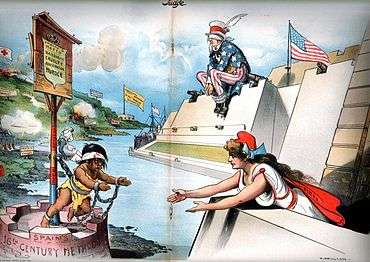
For decades, rebels in Cuba had waged an intermittent campaign for freedom from Spanish colonial rule. By 1895, the conflict had expanded to a war for Cuban independence.[43] The United States and Cuba enjoyed close trade relations, and the Cuban rebellion adversely affected the American economy which was already weakened in the aftermath of the Panic of 1893.[44] As war engulfed the island, Spanish reprisals against the rebels grew ever harsher. These included the removal of Cubans to internment camps near Spanish military bases, a strategy designed to make it hard for the rebels to receive support in the countryside.[45] American opinion favored the rebels, and many Americans viewed Cuba's situation as similar to that of the United States during the American Revolutionary War.[44] As many of his countrymen called for war to liberate Cuba, McKinley favored a peaceful approach, hoping that through negotiation, Spain might be convinced to grant Cuba independence, or at least to allow the Cubans some measure of autonomy.[46] The United States and Spain began negotiations on the subject in 1897, but it became clear that Spain would never concede Cuban independence, while the rebels (and their American supporters) would never settle for anything less.[47] The rebels sponsored a large-scale propaganda war in the American media, where few newspapers supported Spain. [48]
Nevertheless many papers did support McKinley's go-slow policies. Wall Street, big business, high finance and Main Street businesses across the country were vocally opposed to war and demanded peace. After years of severe depression, the economic outlook for the domestic economy was suddenly bright again in 1897. However the uncertainties of warfare a posed serious threat to full economic recovery. "War would impede the march of prosperity and put the country back many years," warned the New Jersey Trade Review. The leading railroad magazine editorialized, "From a commercial and mercenary standpoint it seems peculiarly bitter that this war should come when the country had already suffered so much and so needed rest and peace." McKinley paid close attention to the strong anti-war consensus of the business community, and strengthened his resolve to use diplomacy and negotiation rather than brute force to end the Spanish tyranny in Cuba. [49] On the other hand humanitarian sensibilities reached fever pitch as church leaders and activists wrote hundreds of thousands of letters calling for intervention to political elites at the state and national level; they in turn put pressure on McKinley. Thus the call for a humanitarian intervention was a major factor in forcing McKinley to turn the decision over to Congress, which he knew would declare war. [50]
In January 1898, Spain promised some concessions to the rebels, but when American consul Fitzhugh Lee reported riots in Havana, McKinley agreed to send the battleship USS Maine there to protect American lives and property.[51] On February 15, the Maine exploded and sank with 266 men killed.[52] Public opinion was disgusted with Spain--it had lost control of the situation. McKinley insisted that a court of inquiry first determine whether the explosion was accidental.[53] Negotiations with Spain continued as the court considered the evidence, but on March 20, the court ruled that the Maine was blown up by an underwater mine.[54] As pressure for war mounted in Congress, McKinley continued to negotiate for Cuban independence.[55] Spain refused McKinley's proposals, and on April 11, McKinley turned the matter over to Congress. He did not ask for war, but Congress declared war anyway on April 20, with the addition of the Teller Amendment, which disavowed any intention of annexing Cuba.[56] European powers called on Spain to negotiate and give in; Britain supported the American position.[57] Spain ignored the calls and would fight the war alone.[58]
A Spledid little war: Military and naval operations
Secretary of State John Hay called it “a splendid little war.” Fighting began in April and ended in August on land and sea in North America and East Asia. Ove a million Americans volunteered to fight; fewer than 500 were killed in combat.[59][60]
The telegraph and the telephone gave McKinley a greater control over the day-to-day management of the war than previous presidents had enjoyed. He set up the first war room and used the new technologies to direct the army's and navy's movements.[61] McKinley found Alger inadequate as Secretary of War, and an Army commission agreed.[62] McKinley did not get along with the Army's commanding general, Nelson A. Miles. Bypassing Alger and Miles, the president looked for strategic advice first from Miles's predecessor, General John Schofield, and later from Adjutant General Henry Clarke Corbin.[63] The war led to a change in McKinley's cabinet, as the President accepted Sherman's resignation as Secretary of State; Day agreed to serve as Secretary until the war's end.[64]
Within a fortnight, the navy had its first victory when the Asiatic Squadron, led by Commodore George Dewey, engaged the Spanish navy at the Battle of Manila Bay in the Philippines, destroying the enemy force without the loss of a single American vessel.[65] Dewey's overwhelming victory made him a great hero The next month, McKinley increased the number of troops sent to the Philippines and granted the force's commander, Major General Wesley Merritt, the power to set up legal systems and raise taxes—necessities for a long occupation.[66] By the time the troops arrived in the Philippines at the end of June 1898, McKinley had decided that Spain would be required to surrender the archipelago to the United States. He professed to be open to all views on the subject; however, he believed that as the war progressed, the public would come to demand retention of the islands as a prize of war; furthermore Japan and possibly Germany might seize the islands.[67]
Meanwhile, in the Caribbean theater, a large force of regulars and volunteers gathered near Tampa, Florida, for an invasion of Cuba. The army faced difficulties in supplying the rapidly expanding force even before they departed for Cuba, but by June, Corbin had made progress in resolving the problems.[68] Disease was a major factor: for every American soldier killed in combat in 1898, seven died of disease. The U.S. Army Medical Corps made great strides in treating tropical diseases.[69] There were lengthy delays in Florida--Colonel William Jennings Bryan spent the entire war there as his militia unit was never sent to combat.
The combat army, led by Major General William Rufus Shafter, sailed from Florida on June 20, landing near Santiago de Cuba two days later. Following a skirmish at Las Guasimas on June 24, Shafter's army engaged the Spanish forces on July 2 in the Battle of San Juan Hill.[70] In an intense day-long battle, the American force was victorious, although both sides suffered heavy casualties.[71] Theodore Roosevelt, who had planned the naval war as assistant secretary of the Navy, had resigned, and now with Leonard Wood led the "Rough Riders" into combat, becoming the Army's war hero. His fame propelled them to the governorship of New York in the fall election of 1898.[72] The next day, the Spanish Caribbean squadron, which had been sheltering in Santiago's harbor, broke for the open sea but was intercepted and destroyed by Rear Admiral William T. Sampson's North Atlantic Squadron in the largest naval battle of the war.[73] Shafter laid siege to the city of Santiago, which surrendered on July 17, placing Cuba under effective American control.[74] McKinley and Miles also ordered an invasion of Puerto Rico, which met little resistance when it landed in July.[74] The distance from Spain and the destruction of the Spanish navy made resupply impossible, and the Spanish government--its honor intact after losing to a much more powerful army and navy--began to look for a way to end the war.[75]
Peace and the Philippines
On July 22, the Spanish authorized Jules Cambon, the French Ambassador to the United States, to represent Spain in negotiating peace.[75] The Spanish initially wished to restrict the discussion to Cuba, but were quickly forced to recognize that their other possessions would be claimed as spoils of war.[75] McKinley's cabinet agreed with him that Spain must leave Cuba and Puerto Rico, but they disagreed on the Philippines, with some wishing to annex the entire archipelago and some wishing only to retain a naval base in the area. Although public sentiment mostly to favor annexation of the Philippines, several prominent Democrats, including Bryan and Grover Cleveland were opposed, along with some intellectuals and older Republicans who formed the American Anti-Imperialist League.[76] McKinley decided he had no choice because if the U.S. did not keep the Philippines Japan would seize it.[77] McKinley proposed to open negotiations with Spain on the basis of Cuban liberation and Puerto Rican annexation, with the final status of the Philippines subject to further discussion.[78] He stood firmly in that demand even as the military situation on Cuba began to deteriorate when the American army was struck with yellow fever.[78] Spain ultimately agreed to a ceasefire on those terms on August 12, and treaty negotiations began in Paris in September 1898.[79] The talks continued until December 18, when the Treaty of Paris was signed. The United States acquired Puerto Rico and the Philippines as well as the island of Guam, and Spain relinquished its claims to Cuba; in exchange, the United States agreed to pay Spain $20 million.[80] McKinley had difficulty convincing the Senate to approve the treaty by the requisite two-thirds vote, but his lobbying, and that of Vice President Hobart, eventually saw success, as the Senate voted in favor on February 6, 1899, 57 to 27.[81] Cuba came under temporary American occupation, which gave Army doctors under Walter Reed the chance for major medical reforms and to eliminate yellow fever.[82][83]
Annexation of Hawaii
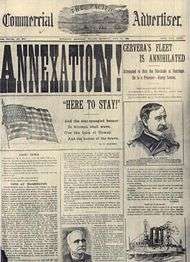
During the war, McKinley also pursued the annexation of the Republic of Hawaii. The new republic, dominated by pro-American business interests, had overthrown the Queen in 1894 when she rejected constitutional limits. Democrats, led by Cleveland, did not want a multiracial possession. Nevertheless, Republicans favored annexation, and the cause gained momentum as the war in the Philippines proved the need for Pacific bases, as Alfred Thayer Mahan had argued.[84] McKinley came to office as a supporter of annexation, and lobbied Congress to adopt his opinion, believing that to do nothing would invite a royalist counter-revolution or a Japanese takeover.[85] Foreseeing difficulty in getting two-thirds of the Senate to approve a treaty of annexation, McKinley instead supported the effort of Democratic Representative Francis G. Newlands of Nevada to accomplish the result by joint resolution of both houses of Congress. The resulting Newlands Resolution passed both houses by wide margins, and McKinley signed it into law on July 8, 1898.[86] McKinley biographer H. Wayne Morgan notes, "McKinley was the guiding spirit behind the annexation of Hawaii, showing ... a firmness in pursuing it";[87] the President told Cortelyou, "We need Hawaii just as much and a good deal more than we did California. It is manifest destiny."[88]
China: Open Door and rebellion
Even before peace negotiations began with Spain, McKinley asked Congress to set up a commission to examine trade opportunities in the region and espoused an "Open Door Policy", in which all nations would freely trade with China and none would seek to violate that nation's territorial integrity.[89] John Hay the new Secretary of State in 1898 circulated notes promoting the Open Door to that effect to the European powers. Great Britain favored the idea, but Russia opposed it; France, Germany, Italy and Japan agreed in principle, but only if all the other nations signed on.[90]
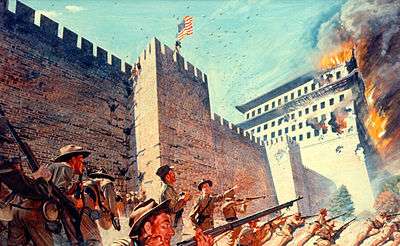
American missionaries were threatened and trade with China became imperiled as the Boxer Rebellion of 1900 menaced foreigners and their property in China.[91] Americans and other westerners in Peking were besieged and, in cooperation with other western powers, McKinley ordered 5000 troops to the city in June 1900 in the China Relief Expedition.[92] The westerners were rescued the next month, but several Congressional Democrats objected to McKinley dispatching troops without consulting Congress.[93] McKinley's actions set a precedent that led to most of his successors exerting similar independent control over the military.[92] After the rebellion ended, the United States reaffirmed its commitment to the Open Door policy, which became the basis of American policy toward China.[94] It used the cash reparations paid by China to bring Chinese students to Americans schools.[95]
Planning the Panama Canal
Hay engaged in negotiations with Britain over the possible construction of a canal across Central America. The Clayton–Bulwer Treaty, which the two nations had signed in 1850, prohibited either from establishing exclusive control over a canal there. The war had exposed the difficulty of maintaining a two-ocean navy without a connection closer than Cape Horn, at the southern tip of South America.[96] Now, with American business, humanitarian and military interests even more involved in Asia, a canal seemed more essential than ever, and McKinley pressed for a renegotiation of the treaty.[96] Hay and the British ambassador, Julian Pauncefote, agreed that the United States could control a future canal, provided that it was open to all shipping and not fortified. McKinley was satisfied with the terms, but the Senate rejected them, demanding that the United States be allowed to fortify the canal. Hay was embarrassed by the rebuff and offered his resignation, but McKinley refused it and ordered him to continue negotiations to achieve the Senate's demands. He was successful, and a new treaty was drafted and approved, but not before McKinley's assassination in 1901.[97] The Panama Canal would eventually be completed in 1914.[98]
Assassination

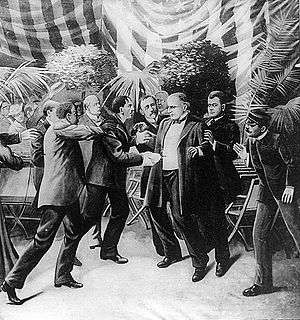
McKinley enjoyed meeting the public, but Cortelyou was concerned with his security due to recent assassinations by anarchists in Europe, such as the assassination of King Umberto I of Italy the previous year, and twice tried to remove a public reception from the President's visit to the Pan-American Exposition in Buffalo, New York.. McKinley refused, and Cortelyou arranged for additional security for the trip.[99] On September 5, the President delivered his address at the fairgrounds, before a crowd of some 50,000 people. In his final speech, McKinley urged reciprocity treaties with other nations to assure American manufacturers access to foreign markets. He intended the speech as a keynote to his plans for a second term.[100][101]
Anarchist Leon Czolgosz was there to assassinate a president. Czolgosz, since hearing a speech by anarchist Emma Goldman in Cleveland, had decided to do answer the call for heroic action. Czolgosz waited at the Temple of Music on the Exposition grounds, where the President was to meet the public. Czolgosz concealed his gun in a handkerchief, and, when he reached the head of the line, shot McKinley twice in the abdomen.[102] McKinley was taken to the Exposition aid station, where the doctor was unable to locate the second bullet. Although a primitive X-ray machine was being exhibited on the Exposition grounds, it was not used. McKinley was taken to the Milburn House.[103]
In the days after the shooting McKinley appeared to improve. Doctors issued increasingly optimistic bulletins. Members of the Cabinet, who had rushed to Buffalo on hearing the news, dispersed; Vice President Roosevelt departed on a camping trip to the Adirondacks.[104] However, unknown to the doctors, the gangrene that would kill him was growing on the walls of his stomach, slowly poisoning his blood. On the morning of September 13, McKinley took a turn for the worse. Relatives and friends gathered around the death bed. At 2:15 a.m. on September 14, President McKinley died. Theodore Roosevelt had rushed back and took the oath of office as president in Buffalo. Czolgosz, put on trial for murder nine days after McKinley's death, was found guilty, sentenced to death on September 26, and executed by electric chair on October 29, 1901.[105]
Gould reports, "The nation experienced a wave of genuine grief at the news of McKinley's passing."[106] The stock market, faced with sudden uncertainty, suffered a steep decline—almost unnoticed in the mourning. The nation focused its attention on the casket that made its way by train, first to Washington, where it first lay in the East Room of the Executive Mansion, and then in state in the Capitol, and then was taken to Canton.[107] A hundred thousand people passed by the open casket in the Capitol Rotunda, many having waited hours in the rain; in Canton, an equal number did the same at the Stark County Courthouse on September 18. The following day, a funeral service was held at the First Methodist Church; the casket was then sealed and taken to the McKinley house, where relatives paid their final respects.[108] It was then transported to the receiving vault at West Lawn Cemetery in Canton, to await the construction of the memorial to McKinley already being planned.[109] McKinley, his wife, and their daughters are interred in the McKinley National Memorial, which was dedicated by President Roosevelt on September 30, 1907.[110]
Elections
Election of 1896
Republican nomination
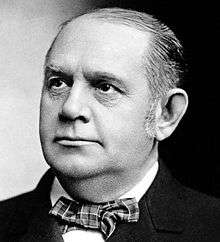
Backed by Hanna's money and organizational skills, McKinley quietly built support for a presidential bid through 1895 and early 1896. When other contenders such as Speaker Reed and Iowa Senator William B. Allison sent agents outside their states to organize Republicans in support of their candidacies, they found that Hanna's agents had preceded them.[111] On McKinley's behalf, Hanna met with the eastern Republican political bosses, such as Senators Thomas Platt of New York and Matthew Quay of Pennsylvania, who were willing to guarantee McKinley's nomination in exchange for promises regarding patronage and offices. McKinley, however, was determined to obtain the nomination without making deals, and Hanna accepted that decision.[112] Many of their early efforts were focused on the South; Hanna obtained a vacation home in southern Georgia where McKinley visited and met with Republican politicians from the region. McKinley needed 453½ delegate votes to gain the nomination; he gained nearly half that number from the South and border states. Platt lamented in his memoirs, "[Hanna] had the South practically solid before some of us awakened."[113]
By the time the national convention began in St. Louis on June 16, 1896, McKinley had an ample majority of delegates. The former governor, who remained in Canton, followed events at the convention closely by telephone, and was able to hear part of Foraker's speech nominating him over the line. When Ohio was reached in the roll call of states, its votes gave McKinley the nomination, which he celebrated by hugging his wife and mother as his friends fled the house, anticipating the first of many crowds that gathered at the Republican candidate's home. Thousands of partisans came from Canton and surrounding towns that evening to hear McKinley speak from his front porch. The convention nominated Republican National Committee vice chairman Garret Hobart of New Jersey for vice president, a choice actually made, by most accounts, by Hanna. Hobart, a wealthy lawyer, businessman, and former state legislator, was not widely known, but as Hanna biographer Herbert Croly pointed out, "if he did little to strengthen the ticket he did nothing to weaken it".[114][115]
General election campaign
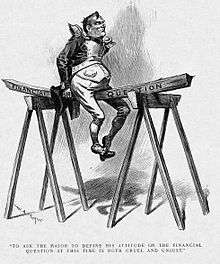
Before the Republican convention, McKinley had been a "straddle bug" on the currency question, favoring moderate positions on silver such as accomplishing bimetallism by international agreement. In the final days before the convention, McKinley decided, after hearing from politicians and businessmen, that the platform should endorse the gold standard, though it should allow for bimetallism by international agreement. Adoption of the platform caused some western delegates, led by Colorado Senator Henry M. Teller, to walk out of the convention. However, compared with the Democrats, Republican divisions on the issue were small, especially as McKinley promised future concessions to silver advocates.[116][117][118]
The bad economic times had continued, and strengthened the hand of forces for free silver. The issue bitterly divided the Democratic Party; President Cleveland firmly supported the gold standard, but an increasing number of rural Democrats wanted silver, especially in the South and West. The silverites took control of the 1896 Democratic National Convention and chose William Jennings Bryan for president; he had electrified the delegates with his Cross of Gold speech. Bryan's financial radicalism shocked bankers—they thought his inflationary program would bankrupt the railroads and ruin the economy. Hanna approached them for support for his strategy to win the election, and they gave $3.5 million for speakers and over 200 million pamphlets advocating the Republican position on the money and tariff questions.[119][120]
 |
McKinley speaks from his front porch
Historic recording of William McKinley. The final 1:08 of this sound file (starting at 5:40) contains an excerpt from one of his 1896 campaign speeches. |
| Problems playing this file? See media help. | |
Bryan's campaign had at most an estimated $500,000. With his eloquence and youthful energy his major assets in the race, Bryan decided on a whistle-stop political tour by train on an unprecedented scale. Hanna urged McKinley to match Bryan's tour with one of his own; the candidate declined on the grounds that the Democrat was a better stump speaker: "I might just as well set up a trapeze on my front lawn and compete with some professional athlete as go out speaking against Bryan. I have to think when I speak."[121] Instead of going to the people, McKinley would remain at home in Canton and allow the people to come to him; according to historian R. Hal Williams in his book on the 1896 election, "it was, as it turned out, a brilliant strategy. McKinley's 'Front Porch Campaign' became a legend in American political history."[121]
McKinley made himself available to the public every day except Sunday, receiving delegations from the front porch of his home. The railroads subsidized the visitors with low excursion rates—the pro-silver Cleveland Plain Dealer disgustedly stated that going to Canton had been made "cheaper than staying at home".[122][123] Delegations marched through the streets from the railroad station to McKinley's home on North Market Street. Once there, they crowded close to the front porch—from which they surreptitiously whittled souvenirs—as their spokesman addressed McKinley. The candidate then responded, speaking on campaign issues in a speech molded to suit the interest of the delegation. The speeches were carefully scripted to avoid extemporaneous remarks; even the spokesman's remarks were approved by McKinley or a representative. This was done as the candidate feared an offhand comment by another that might rebound on him.[122][124][125]
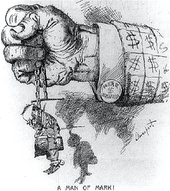
Most Democratic newspapers refused to support Bryan, the major exception being the New York Journal, controlled by William Randolph Hearst, whose fortune was based on silver mines. In biased reporting and through the sharp cartoons of Homer Davenport, Hanna was viciously characterized as a plutocrat, trampling on labor. McKinley was drawn as a child, easily controlled by big business.[126] Even today, these depictions still color the images of Hanna and McKinley: one as a heartless businessman, the other as a creature of Hanna and others of his ilk.[127]
The battleground proved to be the Midwest — the South and most of the West were conceded to Bryan — and the Democrat spent much of his time in those crucial states.[128][129] The Northeast was considered most likely safe for McKinley after the early-voting states of Maine and Vermont supported him in September.[130] By then, it was clear that public support for silver had receded, and McKinley began to emphasize the tariff issue. By the end of September, the Republicans had discontinued printing material on the silver issue, and were entirely concentrating on the tariff question.[131] On November 3, 1896, the voters had their say in most of the nation. McKinley won the entire Northeast and Midwest; he won 51% of the vote and an ample majority in the Electoral College. Bryan had concentrated entirely on the silver issue, and had not appealed to urban workers. Voters in cities supported McKinley; the only city outside the South of more than 100,000 population carried by Bryan was Denver, Colorado.[132]
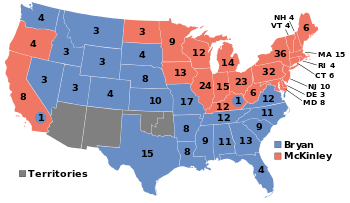
The 1896 presidential election is often seen as a realigning election, in which McKinley's view of a stronger central government building American industry through protective tariffs and a dollar based on gold triumphed. The voting patterns established then displaced the near-deadlock the major parties had seen since the Civil War; the Republican dominance begun then would continue until 1932, another realigning election with the ascent of Franklin Roosevelt.[133] Phillips argues that, with the possible exception of Iowa Senator Allison, McKinley was the only Republican who could have defeated Bryan—he theorized that eastern candidates such as Morton or Reed would have done badly against the Illinois-born Bryan in the crucial Midwest.[134] According to the biographer, though Bryan was popular among rural voters, "McKinley appealed to a very different industrialized, urbanized America."[135]
The major victory confirmed the GOP landslide of 1894 and marked a realigning election In American politics as the nation moved from the Third Party System that it focused on issues of civil war and reconstruction, and entered the Fourth Party System, known as the Progressive Era, which focused on middle class reforms.[136]
1898 election
Republicans retained their majorities in both houses of Congress following the 1898 elections, though Democrats picked up several seats in the House. Following the election, David B. Henderson replaced fellow Republican Thomas Brackett Reed as Speaker of the House.
1900 election
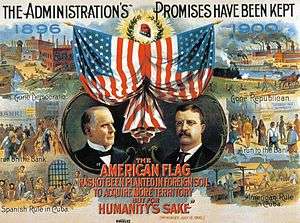
Republicans were generally successful in state and local elections around the country in 1899, and McKinley was optimistic about his chances at re-election in 1900.[137] McKinley's popularity in his first term assured him of renomination for a second.[138] The only question about the Republican ticket concerned the vice presidential nomination; McKinley needed a new running mate as Hobart had died in late 1899.[139] McKinley initially favored Elihu Root, who had succeeded Alger as Secretary of War, but McKinley decided that Root was doing too good a job at the War Department to move him.[139] He considered other prominent candidates, including Allison and Cornelius N. Bliss, but none were as popular as the Republican party's rising star, Theodore Roosevelt.[140] After a stint as Assistant Secretary of the Navy, Roosevelt had resigned and raised a cavalry regiment; they fought bravely in Cuba, and Roosevelt returned home covered in glory. Elected governor of New York on a reform platform in 1898, Roosevelt had his eye on the presidency.[139] Many supporters recommended him to McKinley for the second spot on the ticket, and Roosevelt believed it would be an excellent stepping stone to the presidency in 1904.[139] McKinley remained uncommitted in public, but Hanna was firmly opposed to the New York governor.[141] The Ohio senator considered the New Yorker overly impulsive; his stance was undermined by the efforts of political boss and New York Senator Thomas Platt, who, disliking Roosevelt's reform agenda, sought to sideline the governor by making him vice president.[142]
When the Republican convention began in Philadelphia that June, no vice presidential candidate had overwhelming support, but Roosevelt had the broadest range of support from around the country.[139] McKinley affirmed that the choice belonged to the convention, not to him.[143] On June 21, McKinley was unanimously renominated and, with Hanna's reluctant acquiescence, Roosevelt was nominated for vice president on the first ballot.[144] The Democratic convention convened the next month in Kansas City and nominated William Jennings Bryan, setting up a rematch of the 1896 contest.[145]
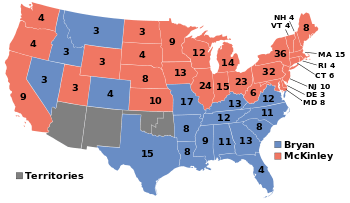
The candidates were the same, but the issues of the campaign had shifted: free silver was still a question that animated many voters, but the Republicans focused on victory in war and prosperity at home as issues they believed favored their party.[146] Democrats knew the war had been popular, even if the imperialism issue was less sure, so they focused on the issue of trusts and corporate power, painting McKinley as the servant of capital and big business.[147] As in 1896, Bryan embarked on a speaking tour around the country while McKinley stayed at home, this time making only one speech, to accept his nomination.[148] Roosevelt emerged as the campaign's primary speaker and Hanna helped the cause working to settle a coal miners strike in Pennsylvania.[149]
Bryan's campaigning failed to excite the voters as it had in 1896, and observers expected McKinley to be re-elected easily.[150] On November 6, 1900, he was proven correct, winning the largest victory for any Republican since 1872.[151] Bryan carried only four states outside the solid South. Bryan in 1896 won his home state of Nebraska over McKinley by over 13,000 votes. McKinley won it in 1900 by more than 7,000 votes. The reasons for the turnabout included prosperity, the collapse of the Populist Party, the intensive Republican campaign in the state, and Bryan's neglect of his base.[152]
Legacy and historical image

McKinley's biographer, H. Wayne Morgan remarks that McKinley died the most beloved president in history.[153] However, the young, enthusiastic Roosevelt quickly captured public attention after his predecessor's death. The new president made little effort to secure the trade reciprocity McKinley had intended to negotiate with other nations. Controversy and public interest surrounded Roosevelt throughout the seven and a half years of his presidency as memories of McKinley faded; by 1920, according to Gould, McKinley's administration was deemed no more than "a mediocre prelude to the vigor and energy of Theodore Roosevelt's".[106] Beginning in the 1950s, McKinley received more favorable evaluations; nevertheless, in surveys ranking American presidents, he has generally been placed near the middle, often trailing contemporaries such as Hayes and Cleveland.[106] Morgan suggests that this relatively low ranking is due to a perception among historians that while many decisions during McKinley's presidency profoundly affected the nation's future, he more followed public opinion than led it, and that McKinley's standing has suffered from altered public expectations of the presidency.[154]
There has been broad agreement among historians that McKinley's election was at the time of a transition between two political eras, dubbed the Third and Fourth Party Systems.[155] Kenneth F. Warren emphasizes the national commitment to a pro-business, industrial, and modernizing program, represented by McKinley.[156] Historian Daniel P. Klinghard argued that McKinley's personal control of the 1896 campaign gave him the opportunity to reshape the presidency—rather than simply follow the party platform—by representing himself as the voice of the people.[157] However, more recently, as Republican political official Karl Rove exalted McKinley as the agent of sweeping political realignment in the 2000s, some scholars, such as David Mayhew, questioned whether the 1896 election truly represented a realignment, thereby placing in issue whether McKinley deserves credit for it.[158] Historian Michael J. Korzi argued in 2005 that while it is tempting to see McKinley as the key figure in the transition from congressional domination of government to the modern, powerful president, this change was an incremental process through the late 19th and early 20th centuries.[159]
Phillips writes that McKinley's low rating is undeserved, and that he should be ranked just after the great presidents such as Washington and Lincoln. He pointed to McKinley's success at building an electoral coalition that kept the Republicans mostly in power for a generation.[160] Phillips believes that part of McKinley's legacy is the men he included in his administration, who dominated the Republican Party for a quarter century after his death. These officials included Cortelyou, who served in three Cabinet positions under Roosevelt, and Dawes, who became vice president under Coolidge. Other McKinley appointees who later became major figures include Day, who Roosevelt elevated to the Supreme Court where he remained nearly twenty years, and William Howard Taft, whom McKinley had made Governor-General of the Philippines and who succeeded Roosevelt as president.[161]
A controversial aspect of McKinley's presidency is territorial expansion and the question of imperialism. The U.S. set Cuba free and granted independence to the Philippines in 1946. Puerto Rico remains in an ambiguous status. Hawaii is a state; Guam remains a territory. The territorial expansion of 1898 was the high water mark of American imperialism.[162] Morgan sees that historical discussion as a subset of the debate over the rise of America as a world power; he expects the debate over McKinley's actions to continue indefinitely without resolution, and notes that however one judges McKinley's actions in American expansion, one of his motivations was to change the lives of Filipinos and Cubans for the better.[163]
Administration and cabinet

At far left: William McKinley. Left to right in back of table: Lyman J. Gage, John W. Griggs, John D. Long, James Wilson standing, and Cornelius N. Bliss. Left to right in front of table: John Hay, Russell A. Alger, and Charles E. Smith
| The McKinley Cabinet | ||
|---|---|---|
| Office | Name | Term |
| President | William McKinley | 1897–1901 |
| Vice President | Garret A. Hobart | 1897–1899 |
| none | 1899–1901 | |
| Theodore Roosevelt | 1901 | |
| Secretary of State | John Sherman | 1897–1898 |
| William R. Day | 1898 | |
| John M. Hay | 1898–1901 | |
| Secretary of Treasury | Lyman J. Gage | 1897–1901 |
| Secretary of War | Russell A. Alger | 1897–1899 |
| Elihu Root | 1899–1901 | |
| Attorney General | Joseph McKenna | 1897–1898 |
| John W. Griggs | 1898–1901 | |
| Philander C. Knox | 1901 | |
| Postmaster General | James A. Gary | 1897–1898 |
| Charles Emory Smith | 1898–1901 | |
| Secretary of the Navy | John D. Long | 1897–1901 |
| Secretary of the Interior | Cornelius N. Bliss | 1897–1899 |
| Ethan A. Hitchcock | 1899–1901 | |
| Secretary of Agriculture | James Wilson | 1897–1901 |
See also
References
- ↑ Phillips, pp. 207–208.
- ↑ Lewis L. Gould, The Presidency of William McKinley (1980). pp. 17–18.
- ↑ H. Wayne Morgan, William McKinley and His America (2nd ed. 2003) pp 194-95
- ↑ Margaret Leech, In the Days of McKinley (1959) pp 152–153
- ↑ Morgan, pp. 194–195, 285; Leech, pp. 152–153.
- ↑ Gould, p. 15; Horner, pp. 236–238.
- ↑ Gould, p. 14.
- ↑ Morgan, pp. 199–200.
- ↑ Phillips, p. 127.
- ↑ Gould, pp. 16–17, 174–176.
- ↑ Connolly, p. 29–31.
- ↑ Horner, pp. 139–140, 240–241.
- ↑ Gould, p. 94.
- 1 2 Semonche, p. 374.
- ↑ Pratt, p. 29.
- ↑ Galloway, Jr., Russell Wl (1 January 1985). "The Taft Court (1921-29)". Santa Clara Law Review. 25 (1): 1–2. Retrieved 4 March 2016.
- ↑ Federal Judicial Center.
- ↑ Julius W. Pratt, "American business and the Spanish-American war." Hispanic American Historical Review 14#2 (1934): 163-201, quote p 166. The only soft spot was in the cotton goods industry.
- ↑ Gould, p. 40.
- ↑ Gould, p. 41.
- ↑ Morgan, pp. 211–212.
- ↑ Gould, pp. 42–45.
- ↑ Jeannette Nichols, "The Monetary Problems of William McKinley." Ohio History 72 (1963): 263-92.
- ↑ Gould, pp. 45–46.
- ↑ Nichols, p. 586; Gould, p. 46.
- ↑ Morgan, pp. 218–219.
- ↑ Gould, pp. 169–171.
- ↑ James Ford Rhodes, The McKinley and Roosevelt Administrations, 1897-1909 (1922) pp 119-20.
- ↑ Thomas A. Bailey, "Was the Presidential Election of 1900 a Mandate on Imperialism?." Mississippi Valley Historical Review 24.1 (1937): 43-52. in JSTOR
- ↑ Richard Jensen, The Winning of the Midwest: Social and Political Conflict, 1888–1896 (1971) pp 269-308.
- ↑ Edward T. James, "T.V. Powderly, a Political Profile." Pennsylvania Magazine of History and Biography 99.4 (1975): 443-459. online
- ↑ John E. Wiltz, "APA-ism in Kentucky and Elsewhere." Register of the Kentucky Historical Society 56.2 (1958): 143-155. in JSTOR
- ↑ Tennant S. McWilliams, "James H. Blount, the South, and Hawaiian Annexation." Pacific Historical Review 1988 57#1: 25–46.
- ↑ Paul H. Buck, Road to reunion, 1865-1900 (1938).
- ↑ David W. Blight (2009). Race and Reunion: The Civil War in American Memory. Harvard UP. p. 266.
- ↑ Kevern J. Verney, The art of the possible: Booker T. washington and black leadership in the united states, 1881-1925 (Routledge, 2013).
- 1 2 3 Gould, pp. 153–154.
- ↑ Gould, p. 155.
- ↑ Bacote, p. 234.
- 1 2 Gould, pp. 156–157.
- ↑ Bacote, pp. 235–237; Leech, p. 348.
- ↑ Gould, pp. 159–160; Phillips, p. 149.
- ↑ Gould, p. 60.
- 1 2 Offner, p. 51-52.
- ↑ Gould, p. 61.
- ↑ Gould, pp. 65–66.
- ↑ Gould, pp. 68–70.
- ↑ Auxier, George W. "The propaganda activities of the Cuban Junta in precipitating the Spanish-American War, 1895-1898." Hispanic American Historical Review 19.3 (1939): 286-305.
- ↑ Julius W. Pratt, "American business and the Spanish-American war." Hispanic American Historical Review 14#2 (1934): 163-201. in JSTOR, quotes on page 168.
- ↑ Jeffrey Bloodworth, "For Love or for Money?: William Mckinley and the Spanish-American War" White House Studies (2009) 9#2 pp 135-157.
- ↑ Gould, pp. 71–72.
- ↑ Gould, p. 74.
- ↑ Leech, pp. 171–172.
- ↑ Leech, p. 173; Gould, pp. 78–79.
- ↑ Gould, pp. 79–81.
- ↑ Gould, pp. 86–87.
- ↑ Sylvia L. Hilton and Steve Ickringill, European perceptions of the Spanish-American War of 1898 (Peter Lang, 1999).
- ↑ Offner, p. 58-59.
- ↑ John M. Murrin; et al. (2015). Liberty, Equality, Power: A History of the American People, Volume 2: Since 1863. Cengage Learning. pp. 723–24.
- ↑ Frank Freidel, The Splendid Little War: The Spanish-American War (1962)
- ↑ Gould, pp. 91–93.
- ↑ Edward Ranson, "The Investigation of the War Department, 1898–99." Historian 34.1 (1971): 78-99.
- ↑ Gould, pp. 102–103.
- ↑ Gould, p. 94; Leech, p. 191.
- ↑ Craig L. Symonds, Decision at Sea: Five Naval Battles that Shaped American History (Oxford UP, 2005) pp 139-96.
- ↑ David P. Barrows, "The Governor-General of the Philippines Under Spain and the United States." American Historical Review 21.2 (1916): 288-311. online
- ↑ Paolo E. Coletta, "McKinley, the Peace Negotiations, and the Acquisition of the Philippines." Pacific Historical Review 30.4 (1961): 341-350.
- ↑ Gould, pp. 104–106.
- ↑ Vincent J. Cirillo, Bullets and bacilli: The Spanish-American War and military medicine (Rutgers UP, 2004).
- ↑ Leech, pp. 249–252.
- ↑ Angus Konstam, San Juan Hill 1898: America's emergence as a world power (Bloomsbury, 2013.
- ↑ Edmund Morris, The Rise of Theodore Roosevelt (1979) pp 646-743.
- ↑ Jim Leeke, Manila and Santiago: The New Steel Navy in the Spanish-American War (Naval Institute Press, 2013).
- 1 2 Gould, pp. 110–112.
- 1 2 3 Gould, pp. 112–113.
- ↑ Fred H. Harrington, "The Anti-Imperialist Movement in the United States, 1898-1900," Mississippi Valley Historical Review (1935) 22#2 pp. 211-230 in JSTOR
- ↑ Ephraim K. Smith, "'A Question from Which We Could Not Escape': William McKinley and the Decision to Acquire the Philippine Islands." Diplomatic History 9.4 (1985): 363-375.
- 1 2 Gould, pp. 118–119.
- ↑ Gould, pp. 120–121.
- ↑ Gould, pp. 142–143.
- ↑ Gould, pp. 144–150; Morgan, p. 320.
- ↑ Graham A. Cosmas, "Securing the Fruits of Victory: The US Army Occupies Cuba, 1898-1899." Military Affairs: The Journal of Military History (1974): 85-91.
- ↑ John R. Pierce, Yellow jack: how yellow fever ravaged America and Walter Reed discovered its deadly secrets (Wiley, 2005).
- ↑ Alfred Thayer Mahan. edited by Francis P. Semya (2003). The Problem of Asia: Its Effect Upon International Politics. Transaction. pp. 10–11.
- ↑ Gould, pp. 49–50.
- ↑ Gould, pp. 98–99.
- ↑ Morgan, p. 223.
- ↑ Morgan, p. 225.
- ↑ Yoneyuki Sugita, "The Rise of an American Principle in China: A Reinterpretation of the First Open Door Notes toward China." in Sugita, ed., Trans-Pacific relations: America, Europe, and Asia in the twentieth century (2003): 3-20.
- ↑ Gould, pp. 202–204.
- ↑ Diana Preston, The Boxer Rebellion: The Dramatic story of China's war on foreigners that shook the world in the summer of 1900 (Bloomsbury, 2000).
- 1 2 Lafeber, p. 714.
- ↑ Gould, pp. 220–222.
- ↑ Gould, p. 233.
- ↑ Teresa Brawner Bevis, and Christopher J. Lucas, International students in American colleges and universities: A history (Macmillan, 2007) pp 63-73.
- 1 2 Gould, pp. 196–198.
- ↑ McCullough, pp. 256–259.
- ↑ John Taliaferro, All the Great Prizes: The Life of John Hay, from Lincoln to Roosevelt ((Simon and Schuster, 2013).
- ↑ Miller, p. 294.
- ↑ Miller, pp. 298–300.
- ↑ Gould, pp. 250–251.
- ↑ Miller, pp. 300–301.
- ↑ Leech, pp. 596–597; Miller, pp. 312–315.
- ↑ Miller, pp. 315–317; Morgan, pp. 401–402.
- ↑ Miller, pp. 321–330.
- 1 2 3 Gould, p. 252.
- ↑ Morgan, pp. 402–403.
- ↑ McElroy, p. 167.
- ↑ Morgan, p. 403.
- ↑ McElroy, pp. 189–193; Morgan, p. 406.
- ↑ Jones, p. 103.
- ↑ Jones, p. 105.
- ↑ Williams, p. 57.
- ↑ Horner, pp. 159–162.
- ↑ Williams, p. 59.
- ↑ Phillips, pp. 52, 81–82.
- ↑ Cherny, pp. 55–56.
- ↑ Jones, p. 177.
- ↑ Gould, pp. 10–11.
- ↑ Leech, pp. 85–87.
- 1 2 Williams, pp. 130–131.
- 1 2 Leech, pp. 88–89.
- ↑ Harpine, p. 52.
- ↑ Williams, pp. 131, 226.
- ↑ Jones, p. 285.
- ↑ Jones, pp. 176–177.
- ↑ Horner, pp. 272, 318.
- ↑ Leech, p. 95.
- ↑ Kazin, p. 68.
- ↑ Phillips, p. 75.
- ↑ Morgan, p. 184.
- ↑ Kazin, pp. 76–77.
- ↑ Williams, p. xi; Phillips, pp. 3, 77.
- ↑ Phillips, pp. 73–77.
- ↑ Phillips, p. 77.
- ↑ Walter Dean Burnham, "The system of 1896: An analysis." in Paul Kleppner et al. The evolution of American electoral systems (1981): 166-69.
- ↑ Gould, pp. 207–208.
- ↑ Gould, pp. 213–214.
- 1 2 3 4 5 Gould, pp. 215–217.
- ↑ Phillips, pp. 120–122.
- ↑ Leech, pp. 531–533.
- ↑ Horner, pp. 260–266.
- ↑ Gould, p. 218.
- ↑ Leech, pp. 540–542.
- ↑ Gould, pp. 219–220.
- ↑ Gould, pp. 226–227; Leech, pp. 543–544.
- ↑ Gould, pp. 227–228; Leech, pp. 544–546.
- ↑ Leech, pp. 549–557.
- ↑ Gould, p. 228.
- ↑ Gould, p. 229; Leech, p. 558.
- ↑ Leech, p. 559.
- ↑ John W. Bailey, Jr., "The Presidential Election of 1900 in Nebraska: McKinley Over Bryan." Nebraska History 54#4 (1973): 560-584.
- ↑ Morgan, p. 404.
- ↑ Morgan, p. 472.
- ↑ Nice, p. 448.
- ↑ Kenneth F. Warren (2008). Encyclopedia of U.S. Campaigns, Elections, and Electoral Behavior. SAGE. p. 211. ISBN 978-1-4129-5489-1.
- ↑ Klinghard, pp. 736–760.
- ↑ Rauchway, pp. 242–244.
- ↑ Korzi, p. 281.
- ↑ Phillips, pp. 156–157.
- ↑ Phillips, pp. 163–164.
- ↑ Phillips, p. 99.
- ↑ Morgan, p. 468.
Further reading
Books
- Gould, Lewis L. (1980). The Presidency of William McKinley. American Presidency. Lawrence, Kansas: University Press of Kansas. ISBN 978-0-7006-0206-3.
- Gould, Lewis L. The Spanish-American War and President McKinley (University Press of Kansas, 1982).
- Harpine, William D. (2005). From the Front Porch to the Front Page: McKinley and Bryan in the 1896 Presidential Campaign. Presidential Rhetoric. 13. College Station, Texas: Texas A&M University Press. ISBN 978-1-58544-559-2.
- Hilderbrand, Robert C. Power and the people: Executive management of public opinion in foreign affairs, 1897-1921 (U of North Carolina Press, 1981).
- Horner, William T. (2010). Ohio's Kingmaker: Mark Hanna, Man and Myth. Athens, Ohio: Ohio University Press. ISBN 978-0-8214-1894-9.
- Jensen, Richard (1971). The Winning of the Midwest: Social and Political Conflict, 1888–1896. Chicago: The University of Chicago Press. ISBN 978-0-226-39825-9.
- Leech, Margaret (1959). In the Days of McKinley. New York: Harper and Brothers. OCLC 456809.
- McCullough, David (1977). The Path Between the Seas: The Creation of the Panama Canal 1870–1914. New York: Touchstone. ISBN 978-0-671-24409-5.
- McElroy, Richard L. (1996). William McKinley and Our America. Canton, Ohio: Stark County Historical Society. ISBN 978-0-9634712-1-5.
- Miller, Scott (2011). The President and the Assassin. New York: Random House. ISBN 978-1-4000-6752-7.
- Morgan, H. Wayne (2003). William McKinley and His America (revised ed.). The Kent State University Press. ISBN 978-0-87338-765-1.
- Olcott, Charles (1916). The Life of William McKinley 2 vol. Boston: Houghton Mifflin. Retrieved March 23, 2012.
- Peifer, Douglas Carl. Choosing War: Presidential Decisions in the Maine, Lusitania, and Panay Incidents (Oxford UP, 2016).
- Ponder, Stephen. Managing the press: Origins of the media presidency, 1897-1933 (Macmillan, 1999).
- Phillips, Kevin (2003). William McKinley. New York: Times Books. ISBN 978-0-8050-6953-2.
- Rhodes, James Ford. The McKinley and Roosevelt Administrations, 1897-1909 (1922) 444pp; online
- Semonche, John E. (2009). "McKenna, Joseph". In Newman, Roger K. The Yale Biographical Dictionary of American Law. New Haven, Connecticut: Yale University Press. ISBN 978-0-300-11300-6.
- Sturgis, Amy H. ed. Presidents from Hayes Through McKinley: Debating the Issues in Pro and Con Primary Documents (Greenwood, 2003).
- Taliaferro, John. All the Great Prizes: The Life of John Hay, from Lincoln to Roosevelt (Simon and Schuster, 2013).
- White, Leonard D. The Republican era: 1869-1901; A study in administrative history (1958) history of federal agencies; no politics .
- Williams, R. Hal (2010). Realigning America: McKinley, Bryan and the Remarkable Election of 1896. Lawrence, Kansas: University Press of Kansas. ISBN 978-0-7006-1721-0.
Articles
- Bacote, Clarence A. (July 1959). "Negro officeholders in Georgia under President McKinley". The Journal of Negro History. 44 (3): 217–239. doi:10.2307/2716432. JSTOR 2716432.
- Bailey, Thomas A. "Was the Presidential Election of 1900 a Mandate on Imperialism?." Mississippi Valley Historical Review 24.1 (1937): 43-52. in JSTOR
- Bloodworth, Jeffrey. "For Love or for Money?: William Mckinley and the Spanish-American War" White House Studies (2009) 9#2 pp 135-157.
- Coletta, Paolo E. "Bryan, McKinley, and the Treaty of Paris." Pacific Historical Review (1957): 131-146. in JSTOR
- Connolly, Michael J. (2010). "'I Make Politics My Recreation': Vice President Garret A. Hobart and Nineteenth Century Republican Business Politics". New Jersey History. 125 (1): 29–31. Retrieved March 4, 2012.
- Fry, Joseph A. "William McKinley and the coming of the Spanish-American War: A study of the besmirching and redemption of an historical image." Diplomatic History 3#1 (1979): 77-98.
- Hamilton, Richard F. "McKinley's Backbone." Presidential Studies Quarterly 36.3 (2006): 482-492. On Cuba.
- Holbo, Paul S. "Presidential leadership in foreign affairs: William McKinley and the Turpie-Foraker Amendment." American Historical Review 72.4 (1967): 1321-1335. in JSTOR
- Kapur, Nick. "William McKinley's Values and the Origins of the Spanish‐American War: A Reinterpretation." Presidential Studies Quarterly 41.1 (2011): 18-38.
- Klinghard, Daniel P. (2005). "Grover Cleveland, William McKinley and the Emergence of the President as Party Leader". Presidential Studies Quarterly. 35 (4): 736–760. doi:10.1111/j.1741-5705.2005.00274.x. JSTOR 27552726.
- Korzi, Michael J. (January 2004). "A New Migration of Political Forces: Party Decline and Presidential Leadership in Late Nineteenth-Century America". Polity. 36 (2): 251–282. JSTOR 3235481.
- Lafeber, Walter (1986). "The 'Lion in the Path': The U.S. Emergence as a World Power". Political Science Quarterly. 101 (5): 705–718. doi:10.2307/2150973. JSTOR 2150973.
- McCormick, Thomas (May 1963). "Insular Imperialism and the Open Door: The China Market and the Spanish–American War". Pacific Historical Review. 32 (2): 155–169. JSTOR 4492154.
- Morgan, H. Wayne. "William McKinley as a political leader." Review of Politics 28#4 (1966): 417-432. in JSTOR
- Nice, David C. (September 1984). "The Influence of War and Party System Aging on the Ranking of Presidents". The Western Political Quarterly. 37 (3): 443–455. doi:10.2307/448445. JSTOR 448445.
- Nichols, Jeannette P. (December 1933). "Silver Diplomacy". Political Science Quarterly. 48 (4): 565–588. doi:10.2307/2142930. JSTOR 2142930.
- Offner, John L. (March 2004). "McKinley and the Spanish-American War". Presidential Studies Quarterly. 34 (1): 50–61. JSTOR 27552563.
- Offner, John. "United States Politics and the 1898 War over Cuba." in Angel Smith and Emma Davilla-Cox eds. The Crisis of 1898 (Palgrave Macmillan UK, 1999) pp. 18-44.
- Rauchway, Eric (July 2005). "William McKinley and Us". The Journal of the Gilded Age and Progressive Era. 4 (3): 235–253. doi:10.1017/S1537781400002644. JSTOR 25144402.
- Saldin, Robert P. "William McKinley and the Rhetorical Presidency." Presidential Studies Quarterly 41#1 (2011): 119-134. online
- Smith, Ephraim K. "William McKinley’s Enduring Legacy: The Historiographical Debate on the Taking of the Philippine Islands" in Crucible of Empire, ed. James C. Bradford. (1993) pp 205-49.
Online
- "Biographical Dictionary of the Federal Judiciary". Washington, D.C.: Federal Judicial Center. Retrieved March 4, 2012. searches run from page, "select research categories" then check "court type" and "nominating president", then select U.S. District Courts (or U.S. Circuit Courts) and also William McKinley.
External links
Official
Speeches
Media coverage
Other
- William McKinley: A Resource Guide, Library of Congress
- Extensive essays on William McKinley and shorter essays on each member of his cabinet and First Lady from the Miller Center of Public Affairs
- McKinley Assassination Ink, a documentary history of William McKinley's assassination
- "Life Portrait of William McKinley", from C-SPAN's American Presidents: Life Portraits, August 23, 1999
| U.S. Presidential Administrations | ||
|---|---|---|
| Preceded by Cleveland |
McKinley Presidency 1897–1901 |
Succeeded by Roosevelt |
